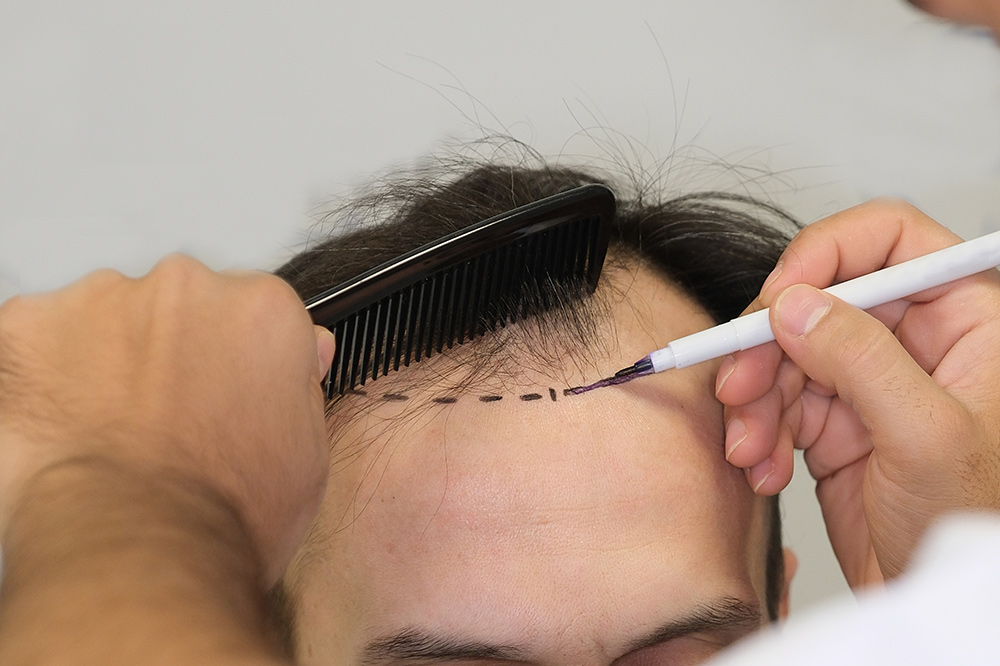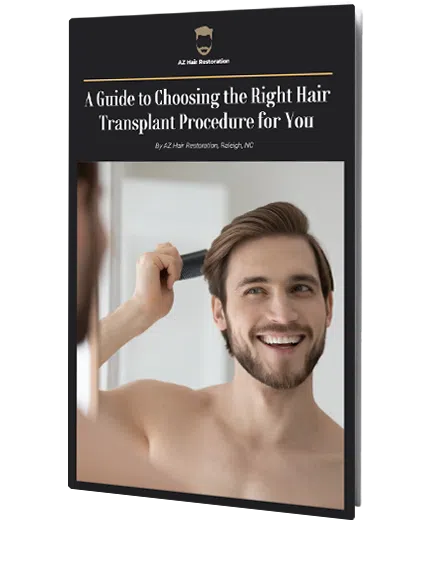What Is a Receding Hairline? Signs, Causes & What You Can Do About It
Last updated on October 15, 2025
Hairlines naturally vary from person to person, but a noticeable shift backward can be concerning. If you are wondering “What is a receding hairline?”, it refers to a gradual movement of the hairline away from the face, typically starting at the temples. This change can occur slowly over several years or more quickly, depending on the cause. Understanding the signs of receding hairline, the reasons it happens, and when it usually begins will help you decide on the right steps to manage it, treat your hair loss, and even reverse your receding hairline.
Common Signs of Receding Hairline
Early detection is important for effective treatment. Key signs of receding hairline include:
- Hair thinning at the temples while the middle of the hairline stays intact
- A more pronounced “M” shape forming along the front hairline
- Increased hair shedding near the forehead
- A widening part at the front of the scalp
- Shorter, finer hairs replacing thicker strands in receding areas
Noticing these changes early gives you more options for slowing or reversing the process.
What Causes a Receding Hairline?
Several factors can contribute to a hairline moving backward:
1. Genetics
The most common cause is androgenetic alopecia, or male and female pattern baldness. This is hereditary and linked to how hair follicles respond to hormones such as dihydrotestosterone (DHT).
2. Hormonal Changes
Shifts in hormone levels due to age, thyroid conditions, pregnancy, or menopause can affect hair growth cycles.
3. Ageing
As we get older, hair naturally becomes finer, and follicles may shrink, making hair loss more noticeable at the hairline.
4. Medical Conditions
Autoimmune diseases such as type 1 diabetes, lupus, rheumatoid arthritis, alopecia areata, scarring alopecia (CCC), scalp infections, or inflammatory skin conditions can cause hairline recession.
5. Stress and Lifestyle Factors
Chronic stress and sleep deprivation, poor diet, or smoking may contribute to hair loss and slow regrowth.
6. Hairstyling Practices
Tight hairstyles that pull on the hairline, such as braids or ponytails, can lead to traction alopecia, which may become permanent if not addressed.
7. Nutritional Deficiencies
Numerous nutritional deficiencies can result in hair loss and many other conditions. AZ Hair Restoration can evaluate you for 33 different nutrient deficiencies.
When Does a Hairline Start Receding?
The timing can vary greatly. In men with a genetic predisposition, hairline changes may begin as early as their late teens or early 20s. In women, it often occurs later, usually after menopause, though it can happen earlier in cases of hormonal imbalance or stress-related shedding.
It is important to remember that not every change in the hairline means permanent hair loss. Temporary factors, such as postpartum shedding or illness, can also cause thinning at the front of the scalp.

The best treatments for a receding hairline depend on the cause and stage of hair loss, but often include DHT-blocking medication, Growth Factor Therapy, and hair transplant surgery. At AZ Hair Restoration in Raleigh, Dr. Arthur Zacco tailors each plan to restore your natural hairline with proven medical or surgical options.
Most Effective Treatment Options for a Receding Hairline
The right treatment depends on the cause, how far the hairline has receded, and your overall health.
1. Medical Hair Growth Treatments
Options include DHT-blocking medications, topical treatments to stimulate follicles, and therapies such as exosomes treatment and Growth Factor Therapy to encourage regrowth and improve hair health.
2. Lifestyle Changes
A balanced diet rich in key nutrients, proper scalp care, and avoiding harsh styling can protect existing hair. Managing stress also helps maintain healthy hair growth cycles.
3. Hair Transplant Surgery
Hair Transplant surgery is the gold standard for hair restoration. Scalp-to-scalp (as opposed to body-to-scalp) hair transplantation results last a lifetime. For more advanced cases, hair transplantation can restore the natural shape of the hairline, and you can get hair transplants for women as well as men. Follicular Unit Extraction (FUE) and Follicular Unit Transplantation (FUT) are proven techniques if performed by experienced physicians.
4. Addressing Underlying Health Issues
If your hairline changes are linked to hormonal or medical conditions, treating these first can improve outcomes.
Why Early Action Matters When You Have Hair Loss
Once follicles have been inactive for too long, they may no longer produce hair. Early intervention can preserve more natural hair and make treatments for thinning hair more effective. If you notice any signs of receding hairline, it is worth seeking an assessment from a hair restoration specialist.
Get Safe, Effective & Innovative Treatments for Hair Loss Today
At AZ Hair Restoration in Raleigh, Dr. Arthur Zacco offers over 30 years of expertise in diagnosing and treating hair loss in men and women. We provide medical hair restoration, surgical options including FUE and FUT hair transplantation, and customised treatment plans with affordable payment options.
Book your free consultation with Dr. Arthur Zacco to discuss your hairline concerns as well as outline a treatment plan customized specifically for you. Also see our before and after photos for proven results.
FAQs
How does a receding hairline differ in men and women?
In men, a receding hairline often starts at the temples, forming an “M” shape, and may progress to the crown. In women, it is more common to see diffuse thinning along the front hairline without a defined pattern. At AZ Hair Restoration in Raleigh, Dr. Arthur Zacco assesses these patterns to create tailored treatment plans. Book your free doctor consultation to learn how we address hairline concerns for both men and women with targeted solutions. You will meet directly with Dr. Arthur Zacco.
When does hairline start receding in men and women?
Men may notice their hairline receding as early as their late teens or 20s, especially with a family history of hair loss. Women often experience it later, often after menopause. Dr. Arthur Zacco in Raleigh can assess your risk and recommend treatments to preserve your hairline. Book your free consultation directly with Dr. Arthur Zacco to discuss prevention and restoration options specifically for you.
Is a receding hairline permanent?
If caused by genetic factors, a receding hairline can progress without treatment. However, early intervention can slow or even fully and permanently restore lost hair. At AZ Hair Restoration, Dr. Arthur Zacco offers advanced medical and surgical treatments, including hair transplantation, to protect and restore your hairline. Book your free hair loss consultation with Dr. Arthur Zacco in Raleigh, North Carolina, to start a personalized plan.
Are there non-surgical treatments for a receding hairline?
Yes, options include prescription medications, Growth Factor Therapy, and other non-surgical treatments to stimulate growth and strengthen existing hair. At our Raleigh clinic, Dr. Arthur Zacco combines these with surgical options when needed. Contact us to learn which treatments suit your condition best.
How quickly can a hairline recede?
The rate of recession varies. Some people notice gradual changes over many years, while others see a more rapid shift in just a few months due to genetics, stress, or illness. At AZ Hair Restoration, Dr. Arthur Zacco can identify the cause and create a targeted plan to slow or stop further loss, and even reverse your receding hairline permanently with a hair transplant. Chat with us today to take action before more hair is lost.









